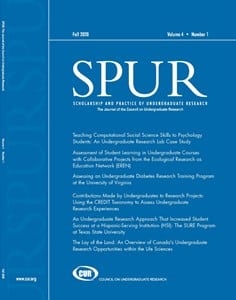SPUR (2020) 4 (1): https://doi.org/10.18833/spur/4/1/5 Abstract:
Data science methods increasingly are utilized to analyze theoretically derived psychological research questions. This article provides a case study of a student-focused research experience that introduced basic data science skills and their utility for psychological research, providing practical learning experiences for students interested in learning computational social science skills. Skills included programming; acquiring, visualizing, and managing data; performing specialized analyses; and building knowledge about open-science practices. Using examples from their teaching experiences, the authors describe how these skills can be incorporated into an active and engaging student learning experience that culminates in computational social science projects and presentations.
More Articles in this Issue
- Assessment‐ Laurel J. Anderson, Jerald J. Dosch, Erin S. Lindquist, Timothy S. McCay, Jose-Luis Machado, Karen Kuers, Tracy B. Gartner, Kathleen L. Shea, Carol Mankiewicz, Vikki L. Rodgers, Patricia A. Saunders, Rebecca A. Urban, Jason S. Kilgore, Amanda S. Powell, Benjamin S. Ramage, J. Megan Steinweg, Jacob N. Straub, Sarah L. Bunnell, and Marissa Witkovsky-Eldred
SPUR (2020) 4 (1): https://doi.org/10.18833/spur/4/1/2 Abstract:Multi-site, course-based undergraduate research experiences (CUREs) in the Ecological Research as Education Network (EREN) were assessed for impacts on student learning of collaborative science skills using a survey that could serve as a starting point for a validated assessment instrument for multisite CUREs. Pretests/posttests were administered across multiple courses and institutions, capturing effects of diverse EREN projects and pedagogies on collaborative knowledge. Students’ scientific collaboration and data management skills improved most in small, upper-level courses. The amount of EREN content in a course was positively associated with posttest scores for 60 to 86 percent of assessment survey questions. However, no learning gains were seen for some questions, and some cases of low competency and effects of timing and place of assessment testing were observed in student scores. EREN CUREs need further development to maximize their potential.
- Assessment‐ Emily Lin, Katherine C. V. Walters, Amy Schmidt-Morris, Hayriye Nilgun Guvener Demirag, Yong Wang, and José Oberholzer
SPUR (2020) 4 (1): https://doi.org/10.18833/spur/4/1/4 Abstract:Diabetes is one of the largest global epidemics, necessitating training for a new generation of scientists and physicians to work on the disease. Undergraduate research experiences can build an educational pipeline for talent in these professions. A NIH-sponsored summer diabetes research internship at the University of Virginia provided undergraduates with opportunities to engage in basic sciences/clinically focused projects mentored by faculty, in areas such as diabetes-related epidemiology, genetics, complications, cell therapy, bioengineering, and artificial pancreas. Lectures, laboratory skills workshops, clinical shadowing, professional development seminars, and a journal club supplemented the intern experience. The post-program survey indicated high satisfaction. Future activities will focus on expanded publicity and recruitment, as well as identification of faculty mentors who can serve as role models for underrepresented individuals in the sciences.
- ‐ Matt Honoré, Thomas E. Keller, Jen Lindwall, Rachel Crist, Leslie Bienen, and Adrienne Zell
SPUR (2020) 4 (1): https://doi.org/10.18833/spur/4/1/3 Abstract:The authors developed a novel tool, the CREDIT URE,to define and measure roles performed by undergraduate students working in research placements. Derived from an open-source taxonomy for determining authorship credit, the CREDIT URE defines 14 possible roles, allowing students and their research mentors to rate the degree to which students participate in each role. The tool was administered longitudinally across three cohorts of undergraduate student-mentor pairs involved in a biomedical research training program for students from diverse backgrounds. Students engaged most frequently in roles involving data curation, investigation, and writing. Less frequently, students engaged in roles related to software development, supervision, and funding acquisition. Students’ roles changed over time as they gained experience. Agreement between students and mentors about responsibility for roles was high.
- Assessment‐ Daniel A. Brown, Nina B. Wright, Sylvia T. Gonzales, Nicholas E. Weimer, and Julio G. Soto
SPUR (2020) 4 (1): https://doi.org/10.18833/spur/4/1/18 Abstract:The STEM Undergraduate Summer Research Experience (SURE) Program provides a holistic approach to undergraduate summer student research to increase student success at Texas State University (TXST), a Hispanic-serving institution. Regarding the 2017–2019 cohorts (composed of 62 undergraduate students), 97 percent persisted after the summer program. After the SURE Program, overall and STEM GPAs were higher in the 2017–2019 cohorts as compared to the control group. SURE students presented 56 posters at national conferences and are second authors in 18 peer-reviewed publications. Fifty-two percent have graduated with their bachelor’s degree, 39 percent are attending graduate or professional programs, and 55 percent of the graduates who are working are in STEM-related fields.
- Perspectives‐ Evelyn Sun, Marcia L. Graves, and David C. Oliver
SPUR (2020) 4 (1): https://doi.org/10.18833/spur/4/1/16 Abstract:This article reviews the state of Canada’s undergraduate research opportunities (UROs) in the life sciences across various institutions. Survey data gathered in 2019 from 20 departments in 14 universities show that all responding departments offer well-established forms of research that include credit-based directed studies or honors-thesis courses. Paid research opportunities are offered by 80–95 percent of the responding departments. Newer-generation UROs such as course-based undergraduate research experiences and inquiry-based lab courses were found to be offered by more than half of responding departments. Additionally, 60 percent reported having co-curricular and student-driven URO initiatives. Overall, the survey data reflect a well-established and growing portfolio of UROs at universities across Canada.
- Vignette‐ Caitlin M. McMahon, Kimberly A. Choquette, S. Chantal E. Stieber, and Erin E. Gray
SPUR (2020) 4 (1): https://doi.org/10.18833/spur/4/1/6 - Vignette‐ Elizabeth A. Majka, Stacey L. Raimondi, and Merrilee F. Guenther
SPUR (2020) 4 (1): https://doi.org/10.18833/spur/4/1/9 - Vignette‐ Sophie Pierszalowski, Greg Heinonen, Bethany Ulman, and Daniel López-Cevallos
SPUR (2020) 4 (1): https://doi.org/10.18833/spur/4/1/10 - Vignette‐ Christopher Fuse, Ashley Cannaday, and Whitney Coyle
SPUR (2020) 4 (1): https://doi.org/10.18833/spur/4/1/13


